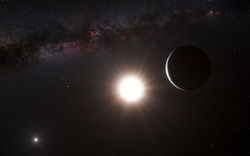Rigil Kentaurus B
| Rigil Kentaurus B | |
 Rigil Kentaurus B and its closest planet. Rigil Kentaurus A can be seen at the lower-left. (Image courtesy ESO) | |
| Stellar characteristics | |
|---|---|
| Constellation | Centaurus |
| Right ascension (Epoch J2000) | 14h 39m 35.0803s |
| Declination (Epoch J2000) | -60° 50' 13.761" |
| Spectral type | K1V |
| Distance from Sol | 4.365 ± 0.007 ly |
| Other designations | Alpha Centauri B, α Cen B, α² Centauri, GJ 559 B, HR 5460, HD 128621, LHS 51, HIP 71681 |
| Planets | Nessus (Kentaurus B I) Eurynomus (Kentaurus B II) Chiron (Kentaurus B III) |
This much dimmer companion star to Rigil Kentaurus A is a main sequence, reddish-orange dwarf (K0-1 V). It appears to have only 93.4 ± 0.7 percent of Sol's mass,[1] about 86.5 percent of its diameter, and 45 to 52 percent of its luminosity.[2] Viewed from a planet at Earth's orbital distance around Alpha Centauri A, this companion B star would provide more light than the full Moon does on Earth as its brightest night sky object, but the additional light at a distance greater than Saturn's orbital distance in the Solar System would not be significant for the growth of Earth-type life.
(Boilerplate from SolStation.com)
Together with Alpha Centauri A and Proxima Centauri, Alpha Centauri B forms a loose trinary system[3], and is one of the closest stars to Sol at a distance of about 4.40 light-years. Alpha Centauri A and B orbit a common point at an average distance of about 23.7 AUs.
Rigil Kentaurus B System
The Kentaurus B system was first surveyed by Trekkies operating out of Starbase 2 in 2009-10. The system consists of three planets (Nessus, Eurynomus, and Chiron) and an extensive asteroid belt (known locally as the Centaur Belt).
Chiron is notable as it is the only world in the Centauri trisystem that is both life-bearing and habitable by humans. Colder and drier than Earth (less than half of Chiron's surface is covered by water, and a mean temperature of only 4C) the planet has extensive polar icecaps and continental deserts. Despite this, Chiron has been tagged as the most likely place for an extrasolar colony to develop. Federation and 'Danelaw scientists have established the Saganville research station on Chiron to study the local life and determine the possible impact colonization would have on the ecosystem.
=Notes
- Jump up ↑ Guedes et al, 2008; and Thévenin et al, 2002
- Jump up ↑ ESO; and Johnson and Wright, 1983, page 681
- Jump up ↑ There is some debate about whether or not Proxima Centauri is actually part of a trinary system with the others, see SolStation.com for more details.